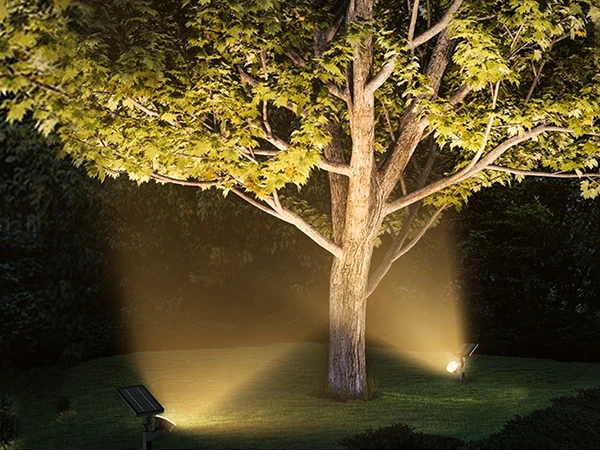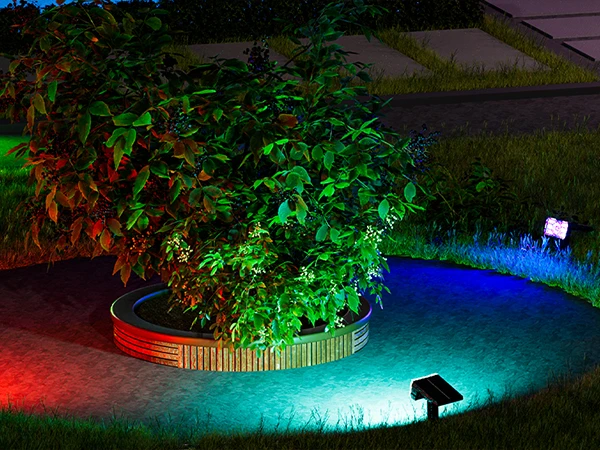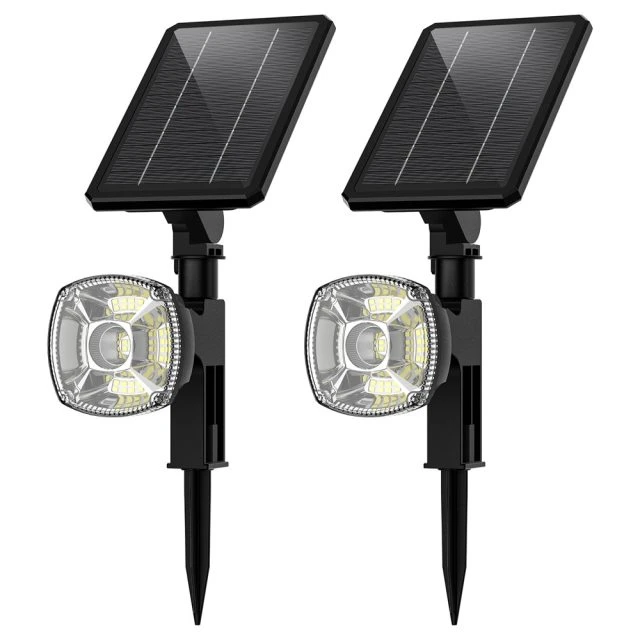As dusk settles, a North American garden fades into vague silhouettes—until a Solar floodlight casts a precise beam on a century-old maple, its branches casting intricate shadows like a natural relief on the wall. A nearby fountain glimmers under another focused beam, its water sparkling with dynamic light. This interplay of Focused lighting and ambient night creates a delicate balance: Solar floodlights highlight key features—trees, sculptures, water features, or facades—while preserving the serene backdrop of the natural nightscape. For North American yards (typically 500-1000㎡), Solar floodlights offer an eco-friendly, artistic solution to craft Night drama without contributing to light pollution. This guide explores how to use Solar floodlights to narrate your garden’s story, adapting to seasonal shifts and festive decorations while ensuring energy efficiency and glare control. With a landscape artist’s lens, we provide actionable designs to elevate your yard’s aesthetic and emotional resonance.

The Art of Light: Focused Illumination Meets Night Serenity
Solar floodlights are more than illuminators—they are storytellers. Unlike diffuse lighting that washes out a garden’s character, Focused lighting uses precise beams to sculpt focal points, creating contrast that makes trees, sculptures, or facades stand out against the night. By minimizing light pollution, these lights preserve the starry sky cherished in North American suburbs. For instance, a well-angled Solar floodlight can transform a bare winter oak into a stark, poetic silhouette or make a summer fountain dance with reflected light. This guide details how to position Solar floodlights for maximum impact, integrate them with festive decor like Solar string lights, and optimize their efficiency for North American climates and lifestyles.
1. Strategic Placement: Height, Angle, and Distance
Effective Solar floodlight placement hinges on three parameters—height, beam angle, and projection distance—tailored to North American yard scales and landscape features.
- Height: Mount Solar floodlights 2-3m above ground for trees (1.5-2m for shorter shrubs) to ensure light reaches upper branches without ground-level glare. For sculptures, position lights 0.5-1m above the sculpture’s top to highlight its form without overshadowing nearby plants.
- Beam Angle: Use narrow beams (15-25°) for single focal points like a tree trunk or statue, creating sharp contrast. Wide beams (35-50°) suit broader features like flower beds or small ponds, ensuring even coverage without harsh edges.
- Projection Distance: Set the light 1.5-2 times the height or width of the target (e.g., a 3m-tall sculpture needs a 4.5-6m distance). Too close distorts shadows; too far weakens intensity.
- Checklist: After installation, confirm no light spills into neighboring windows (glare control), and measure off-target light at ≤10lux to ensure light pollution minimization.
2. Crafting Narratives: Lighting Key Landscape Elements
Each garden element—trees, sculptures, water features, or facades—tells a unique story when lit thoughtfully. Below are tailored Solar floodlight strategies to enhance Night drama.
Trees: Sculpting Natural Silhouettes
- Approach: Use a narrow-beam (15-25°) Solar floodlight, mounted 2-3m high, angled 45° from above the trunk base to highlight bark texture. In winter, bare branches form a “light-shadow skeleton”; in summer, leaves create a translucent, layered effect.
- Design Tip: Avoid aiming at the canopy to prevent a flat, overexposed look. Warm white (2700K) enhances earthy tones of oaks or maples.
- Example: A Boston homeowner lit a 100-year-old maple with a 15°-beam Solar floodlight, its shadows dancing on a stone wall, creating a “natural mural” year-round.
- Checklist: Ensure light focuses on the trunk, with no spillover onto upper foliage (keeps contrast sharp).
Sculptures: Highlighting Form and Material
- Approach: Choose light color based on material—warm white (2700K) for stone to emphasize texture, cold white (5000K) for metal to enhance sheen. Use a narrow beam (20°) to frame the sculpture, keeping edges clear of surrounding plants.
- Design Tip: Position the Solar floodlight 0.5m above the sculpture, angled downward 30°, to avoid blurring the focal point.
- Example: A Chicago family’s bronze statue glowed under a 5000K Solar floodlight, its metallic sheen becoming the yard’s nighttime centerpiece.
- Checklist: Verify the beam doesn’t illuminate adjacent greenery, maintaining focus on the sculpture.
Water Features: Capturing Dynamic Motion
- Approach: Use anti-glare Solar floodlights with hoods, positioned low (0.5-1m) and angled 15° from the water’s edge to light the flow, not the surface, avoiding reflective glare. Cold white (5000K) enhances water’s sparkle, creating a “dancing light” effect.
- Design Tip: For fountains or ponds, ensure IP68-rated lights for submersion or splash resistance, especially in rainy regions like the Pacific Northwest.
- Example: A Denver couple’s fountain shimmered under a low-angled Solar floodlight, its water jets casting dynamic shadows across the yard.
- Checklist: Confirm no direct reflection into eyes (glare control) and store submersible lights before winter freezing in cold climates.

Facades: Enhancing Architectural Character
- Approach: Use wide-beam (40-50°) Solar floodlights, mounted at ground level and angled 30° upward, to create a gradient wash on walls or porches. This highlights textures like brick or climbing vines (e.g., wisteria).
- Design Tip: Warm white (2700K) complements rustic or colonial facades; neutral white (3500K) suits modern homes.
- Example: A Virginia family’s stone porch glowed under two Solar floodlights, their light revealing ivy contours and brickwork for a timeless look.
- Checklist: Ensure light fades softly at the wall’s top to avoid harsh cutoffs, preserving Night drama.
3. Festive and Seasonal Flexibility: Adapting to Traditions
Solar floodlights shine in North America’s festive and seasonal contexts, pairing with Solar string lights for dynamic, adaptable displays.
Christmas Season
- Setup: Use a narrow-beam (15°) Solar floodlight to highlight a Christmas tree’s form from below, emphasizing its silhouette. Wrap Solar string lights (2700K, 50-100 lumens per bulb) around branches for a starry effect, softening the floodlight’s intensity.
- Aesthetic: The floodlight defines the tree’s structure, while string lights add festive warmth, creating a balanced holiday glow.
- Example: A Minnesota family’s Christmas tree stood out with a Solar floodlight base and string light accents, visible from the street without overpowering the night.
Thanksgiving
- Setup: Aim a warm white (2700K) Solar floodlight at a pumpkin or corn display, using a wide beam (40°) with soft edges to blend into the lawn’s dark tones.
- Aesthetic: The warm light enhances autumnal hues, creating a cozy, inviting contrast against the night.
- Example: A New England homeowner’s Thanksgiving decor popped under a Solar floodlight, its soft beam making pumpkins a focal point without harsh glare.
Seasonal Shifts
- Spring: Use a wide-beam (50°) Solar floodlight to illuminate rose beds, highlighting vibrant blooms.
- Summer: Redirect to water features with anti-glare lights for dynamic reflections.
- Fall: Focus narrow beams (20°) on maple trees to showcase fiery leaves.
- Winter: Angle lights upward on bare branches for stark, dramatic silhouettes.
- Checklist: Ensure light colors match across floodlights and string lights (e.g., all 2700K for warmth) to maintain cohesive aesthetics.
4. Energy Efficiency and Automation: Smart Lighting for North American Lifestyles
Solar floodlights maximize energy efficiency while aligning with North American climate variations and daily routines.
Light Control
- Intensity Adjustment: Select Solar floodlights with variable brightness—70% from 18:00-20:00 for peak activity, dropping to 30% post-20:00 for subtle focal outlines. This saves 50% energy while maintaining Night drama.
- Example: A California family’s floodlights dimmed automatically after 20:00, keeping their oak tree visible without wasting power.
Daylight Sensing
- Adaptation: Choose lights with daylight sensors that adjust to regional day lengths (e.g., 14 hours in California vs. 9 hours in Washington). This ensures reliable charging even in short winter days, supporting energy efficiency.
- Example: A Seattle homeowner’s Solar floodlights ran 5 hours in winter vs. 8 hours in summer, auto-adjusting without manual input.
Time-Based Control
- Scheduling: Set lights for 17:00-22:00 in winter and 19:00-23:00 in summer, matching North American evening routines. Timers reduce unnecessary runtime, cutting energy use by 20-30%.
- Checklist: Test schedules to confirm lights activate during peak family activity, avoiding dark gaps or excessive operation.
Conclusion: Weaving Stories with Light
Solar floodlights do more than illuminate—they craft a visual poem for your garden. By focusing beams on trees, sculptures, water features, or facades, they create Night drama that elevates the ordinary into the extraordinary. A maple’s winter branches become a stoic silhouette; a fountain’s summer ripples dance like scattered diamonds. Paired with Solar string lights for festive cheer or seasonal shifts, these lights adapt to North America’s traditions and climates while minimizing light pollution. With precise placement, glare control, and energy-efficient automation, Solar floodlights transform your yard into a nighttime narrative—one that resonates with the emotional warmth of home, season after season.

Comments